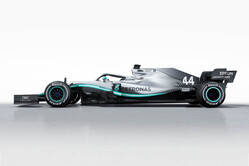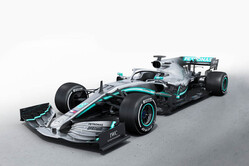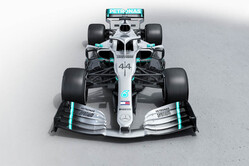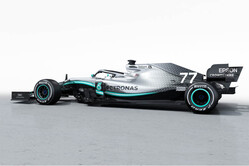 With a little over four weeks to go until the start of the 2019 season, Mercedes today completed the first laps with its 2019 challenger, the F1 W10 EQ Power+.
With a little over four weeks to go until the start of the 2019 season, Mercedes today completed the first laps with its 2019 challenger, the F1 W10 EQ Power+.
The car ran on the 2.98 km Silverstone International Circuit this morning with Valtteri Bottas behind the wheel, to be followed by Lewis Hamilton this afternoon.
"The 2019 season will be a new challenge for all of us," said Toto Wolff. "The regulations have changed quite substantially. We have to start from scratch, we need to prove ourselves again - against our own expectations and against our competitors. We start the season with zero points, so we're taking nothing for granted and there's absolutely no feeling of entitlement to be at the front. In fact, with the regulation change for the new season, every team can have a shot at the title and we're seeing all of them as a potential threat."
Today's running constitutes an official 100 km filming day, which the team will also use as a final systems check before the first pre-season test in Barcelona.
"We're eager to hit the ground running in Barcelona, to benchmark ourselves against our own simulations and see if our predictions materialise on track," added Wolff. "We will focus on ourselves, building up performance and hopefully be ready when the first really competitive session starts on Saturday in Melbourne."
 Compared to its predecessor, the W10 has been changed substantially. The majority of those modifications were driven by the significant changes to the technical regulations for the 2019 season.
Compared to its predecessor, the W10 has been changed substantially. The majority of those modifications were driven by the significant changes to the technical regulations for the 2019 season.
"Regulation changes are both opportunity and threat," admits Technical Director, James Allison. "They are an opportunity because all the old assumptions about what you need to have to be quick are swept away and, if you are fleet of foot and smart in dealing with that, you can do better than all the other teams that are tackling the same change. They are a threat because if you are not as smart and you didn't see how to make the most of these new regulations, then you'll certainly suffer in the coming season. But they are always exhilarating because you have that sharp sense of anxiety that you might not be doing enough but equally the thrill and excitement of looking forward to finding out."
In addition to dealing with the changes to the aerodynamic regulations, which were the main focus in the development of the W10, the team worked hard to improve the weaker areas of the previous car and further build on its strengths.
"The handling of the W09 was a big improvement over the rather idiosyncratic W08," Allison continued. "We managed to be competitive at tracks which had plagued us in recent years. However, notwithstanding this improvement, we were still not as good as some of our competitors at preserving the performance of the rear tyres. We have worked hard on the suspension and aerodynamic characteristics to deliver a car that will be much kinder to its tyres - enough, we hope, to allow us to be competitive at all phases of the race and at each track on the calendar.
"Even though the minimum weight limit was lifted by 10kg for 2019, weight reduction remains a real challenge on the current generation of F1 cars. Components that we felt were stripped to the bone in 2018 have been taken, one by one, and subjected to a further round of aggressive analysis to shave further weight from them. Some components surrender what feels like a giant step of half a kilo, others just a few grams, but collectively each of these victories add up to a handful of kilos that have been invested back in the car on aerodynamics, suspension and Power Unit to bring performance."
 Despite significant changes to many areas of the car, the W10 also retains some of the characteristics of its predecessors, as the general architecture and the wheelbase stay the same.
Despite significant changes to many areas of the car, the W10 also retains some of the characteristics of its predecessors, as the general architecture and the wheelbase stay the same.
"A close inspection will reveal that the execution of this concept has been further refined," said Allison. "Every item is pushed tighter, made more slender - each change permitting us to improve the aerodynamic performance beyond what would have been possible had we accepted the physical limitations of the 2018 design."
While the chassis development was partly driven by regulatory changes, the Power Unit regulations remained largely stable, making the development work more of an evolutionary process in which the team worked hard to achieve two main goals - improving performance and reliability.
"We've made changes to the cooling architecture of the Power Unit, which hopefully provide aerodynamic benefit on the car and also provide efficiency benefit on the Power Unit - so, hopefully a win on both the chassis and on the Power Unit," said Andy Cowell, Managing Director of Mercedes-AMG High Performance Powertrains. "Right at the heart of the Power Unit is the conversion of fuel into heat release in the combustion chamber and useful work out of the crankshaft. We have made steps on the combustion efficiency and on the ERS system. The marriage between the turbocharger assembly with the MGU-H, the inverter, the cells and the MGU-K: that whole system is now capable of operating more efficiently and helping with energy deployment through a race."
The team's title partner Petronas played an important role in the hunt for improved performance and reliability, especially in the development of the new Power Unit.
"The fuel is right at the heart of the combustion and making sure that the chemical composition and the thermodynamic architecture of the Power Unit are working together exceptionally well is key to thermal efficiency," said Cowell. "Petronas have continued to work well with our thermodynamic engineers, we've run many candidates on the single cylinder and on the V6 engine to derive a new fuel for 2019. It's a very tight-knit group, the Petronas engineers know exactly how the engine works and our Power Unit engineers know exactly how the fuel works. Petronas also provide the lubricants for our car which play two roles: to make sure that components don't contact, it's key that there is an oil film between highly loaded components both for reliability and for friction reduction. If you can keep components apart the friction is lower, and the wear is lower, but the lubricant also provides cooling within the engine. It's a critical element of the engine, it's the lifeblood of the engine for its survival."
 The maximum race fuel allowance has increased by 5 kilograms to a total of 110 kilograms. However, the higher fuel allowance does not impact the thermal efficiency of F1 Power Units, which are among the most efficient engines ever-built.
The maximum race fuel allowance has increased by 5 kilograms to a total of 110 kilograms. However, the higher fuel allowance does not impact the thermal efficiency of F1 Power Units, which are among the most efficient engines ever-built.
"If you have got an efficient engine with efficient aerodynamics and you are prepared to do a little bit of lift and coasting, then you have the opportunity to start the race at less than 110kg," explained Cowell. "For every 5kg of weight you save, it's about two tenths of a second a lap quicker, so there is a natural reward to starting the race a little bit lighter. There is still a competitive edge from making an efficient car - both Power Unit and aerodynamics - and racing smartly to make sure that you have good pace at the start of the race as well as through the race."
Work on the all-new car started 16 months ago, when the team was still fighting for its fourth championship title. The development work was spearheaded by a small group of engineers, working on the general concept of the car. Over the course of the 2018 season and in the midst of an exciting and challenging championship fight, more and more engineers in both Brixworth and Brackley started working on the W10.
"Work on the W10 project began at the end of 2017," says Allison. "That's when the first meetings happened about how the chassis was going to be laid out, how the Power Unit was going to change from the previous season and what our rough objectives were for the project. That was when we set out the plans for our deployment of resources, developing and racing the car in 2018 and the right number of the right people to design, conceive and then create the new car for 2019."
On the chassis side, more than half of the engineers in the design office were working on the W10 by the 2018 F1 summer break. In October, when the F1 circus headed to the Americas and both the team and Lewis claimed their fifth World Championship titles, the factory was working flat out on the W10, designing and producing parts of the future contender. Overall, about 7000 drawings were released for manufacture.
Over the winter, many of the major components and sub systems like the transmission, the suspension, the cooling system and the Power Unit underwent rigorous testing, in which they were subjected to loads, temperatures and fatigue cycles similar to those they would experience in the F1 season. Before the car left the garage for the first time today, the team had tested something close to half a million kilometres cumulatively across all these different components.
"There are hours and hours that go into each piece, each assembly, each system, each full element and then the final Power Unit," said Andy. "It is a huge moment when the Power Unit bursts into life and those countless hours are rewarded with fuel being converted into useful work. Yes, it is a machine, but it is part of people's lives and it's personal."
The initial "Fire-Up" is another one of those special moments as it is the first time when all the core systems - the hydraulic system, the electrical system, the fuel system, the cooling system, the gearbox, the chassis and of course the Power Unit - are assembled and the engine runs for the first time in unison with the other systems.
"You've had a factory which had fallen silent for a few weeks, from the end of the last season to this moment, where an engine leaps into life in the factory again," said James. "Even if you're not down in the build shop, you can hear it, so is has a certain emotional impact on us because a motor is running and it is the living proof that all those components are not only assembled but they function. At the same time, you know that you're only about half way there through the about 90 planned test events."
 The 2019 season plays a special role for the team, as the year of the 1000th Formula One Grand Prix is also the tenth season in modern-day F1 for Mercedes as a works team.
The 2019 season plays a special role for the team, as the year of the 1000th Formula One Grand Prix is also the tenth season in modern-day F1 for Mercedes as a works team.
"We've come a long way since 2010 when we re-joined Formula One with a Mercedes works team," says Wolff. "We had a steep learning curve in the first few years, building the long-term capability of the team and continuously improving our performance. We saw the first good season in 2013, when we finished second. After that we've been on a winning streak with five consecutive double championships - an incredible success that none of us in the team, even in our wildest dreams, would have believed possible, especially since we were up against formidable opponents."
Together with its parent company, the team also celebrates 125 years of motorsport in 2019: in 1894, Daimler engines won the world's first motor car race in 1894 from Paris to Rouen as two cars fitted with a Daimler two-cylinder V-engine shared first prize in the 126 kilometre race.
2019 is also the 85th anniversary of the Silver Arrows, as the Eifelrennen, held on 3 June 1934 at the Nurburgring was the first race in which the Mercedes-Benz W 25 competed.
Legend has it that the metallic silver skin was only exposed the night before the race, by grinding off the car's white paint to bring the starting weight of the W 25 down to the limit determined by the race regulations.
The 2019 challenger celebrates this important year in the company's motorsport history with a new design which has been reduced to two main elements. The first element of the star pattern provides the elegance and luxury of Mercedes-Benz, combining high-grade technology and craftsmanship. The second element is a single, strong Petronas green flow line that brings speed and dynamism.
And just like the original Silver Arrows from 1934, the livery of the W10 also brings a performance advantage as the new design sees a slight weight benefit compared to last year.
Check out our Mercedes W10 reveal and shakedown gallery, here.


























sign in